War photographer James Nachtwey
graces Berkeley Graduate School of Journalism
Explains purpose and compassion trumps
all obstacles to document global suffering and injustice
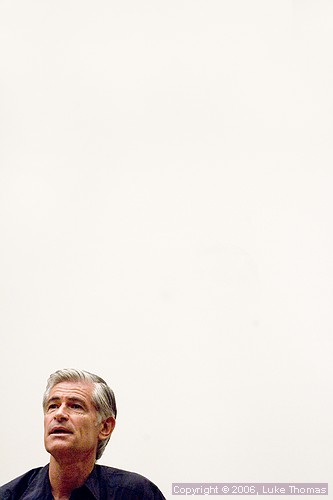
James Nachtwey
Photo(s) by
Luke Thomas
By Aldrich M. Tan
May 12, 2006
Click... Adjust exposure... Click...
The dust settles as freelance magazine photographer James Nachtwey
snaps a photo of young and old Indonesian miners struggling to
carry heavy loads on their bare backs. Nachtwey is at a sulfur
mine in Kwah Ijen, documenting the daily horrendous conditions
the miners endure for pittance in pay.
The miners look like ghosts in a distance covered in the wispy
poisonous fumes that surround them. They gasp and cough from the
foul air, as does Nachtwey while adjusting for correct exposure.
Yet, their hopes for a better future for their families give the
local miners the strength to continue working in such hellish
conditions.
Nachtwey said his subjects' sense of hope under the direst of
situations keeps him going as a freelance photographer for Time
magazine, despite the horrors he has personally witnessed. Through
his experiences documenting humans living in the most troubled
hotspots of the globe, Nachtwey said he has found a higher purpose
in his photographs and parlays his compassion through an extraordinary
body of work.
"Photography can be a powerful antidote to war," Nachtwey
said to an attentive audience at UC Berkeley's Graduate School
of Journalism Thursday evening.
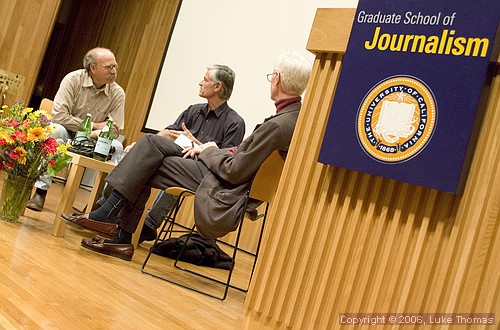
Nachtwey's narratives have taken him to some of the most hostile
areas of the globe, recently Iraq where he documented a platoon
of American soldiers for Time magazine two years ago.
"Someone threw a grenade into the Humvee," Nachtwey
reflected. "The reporter lost his hand and I was wounded."
After his injury, Nachtwey expressed reluctance about going back
to Iraq, but plans to return soon because there is a story that
he wants to continue telling.
"Put yourself in the hands of an Iraqi citizen who is trying
to live their life," Nachtwey posited. "These people
are watching a regime cutting people's heads off and they are
wondering, 'Do we want these kinds of people running our country?'
They are in a serious dilemma."
Not everyone can go to Iraq and witness the challenges of creating
a new democracy amidst terrorism first-hand, Nachtwey said.
"And that's why photographers go there," Nachtwey suggested.
Nachtwey reflected on serving as an eyewitness to Sept. 11. He
was among the many photographers in New York who captured the
World Trade Center towers collapsing.
"I woke up and saw the first tower was spewing black smoke
so I thought the building was on fire," Nachtwey recalled.
"As I got my camera ready, I saw the second tower spew black
smoke too. I understood at that moment that it was a terrorist
attack."
Nachtwey said he spent all day at Ground Zero.
"It looked like a science fiction scene of the apocalypse,"
Nachtwey recalls. "You couldn't see the victims because they
were buried under the rubble, but I did see a hand rising up from
the ruins."
Ken Light, adjunct professor for the UC Berkeley Graduate School
of Journalism, asked Nachtwey if he was afraid to go to such frightening
places.
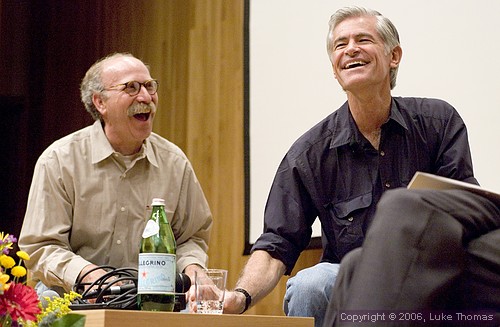
Documentary photographer and UC Berkeley professor, Ken Light
(left)
"Fear is an obstacle and there are many obstacles in life,"
Nachtwey said, "If you have a purpose and a reason why you
are there, then you will find a way to overcome the obstacle."
Mark Danner, journalism graduate school professor, asked Nachtwey
why all the photos he takes portray suffering.
"It always seems like the products that the media wants
the public to see of these places must always be violence, suffering
and degradation," Danner said.
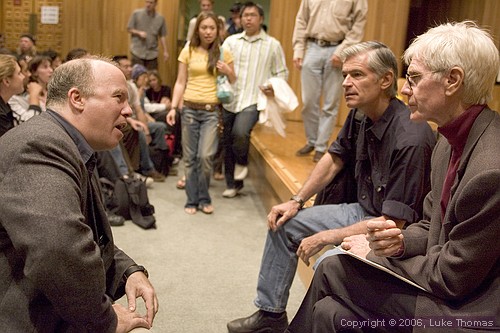
Mark Danner (left), James Nachtwey
and UC Berkeley Graduate School of Journalism Dean, Orville Schell.
Nachtwey said his photography always carry messages of hope.
"The people that I photograph are in the direst of situations
and yet they still have hope for the future," Nachtwey said.
When asked about his faith by an audience member, Nachtwey said
he has faith in people.
"We created the problems of this world and we have the power
to create solutions," Nachtwey said.
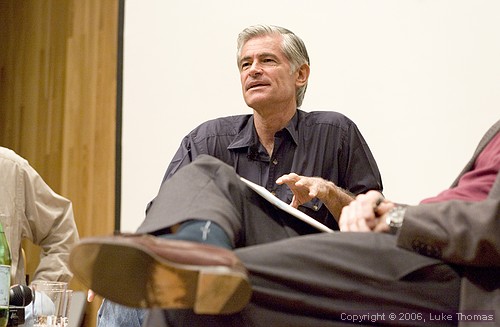
Trevor Meeks, a freelance photographer for the Sonoma Valley
Sun, said Nachtwey's work continues to inspire him and many young
photojournalists.
"He has found a higher purpose in photojournalism,"
Meeks said.
Born in Syracuse, New York, Nachtwey grew up in Massachusetts
and studied art history and political science at Dartmouth College.
In 1976, he worked as a news photographer at the Albuquerque Journal
in New Mexico and then moved to New York to start a career as
a freelance magazine photographer in 1980.
His photographic essays of global war and poverty from South
Africa, Iraq, Kosovo, Rwanda and Indonesia have graced Time magazine
since 1984. His photos have garnered Nachtwey accolades of awards,
including the two World Press Photo Awards and the title of Magazine
Photographer of the Year seven times.
Visit www.jamesnachtwey.com
to view Nachtwey's photographic essays from Indonesia, Kosovo,
9/11, Bosnia, Romania and Afghanistan, also available
in his book entitled "Inferno."
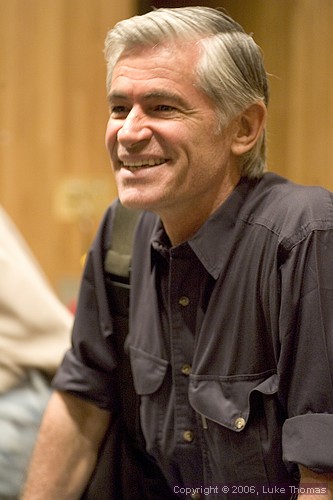
Luke Thomas contributed to this report.
####
|